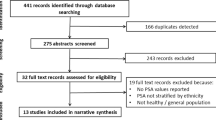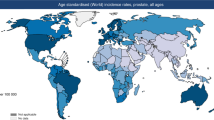Abstract
Background:
The ratio of the second to the fourth digit (2D:4D ratio) is a sexually dimorphic trait established in utero that differs between ethnic groups. It is associated with prenatal androgen exposure, and studies have evaluated the ratio as a marker for certain traits and disease states known to be associated with higher levels of in utero androgens, such as prostate cancer. There are currently no screening tools that stratify men with prostate cancer according to the severity of their disease. This study aims to investigate the 2D:4D ratio as a potential marker for prostate cancer severity. Our hypothesis was that lower digit ratios, representing higher in utero androgen exposure, would be associated with more severe disease.
Methods:
Measurements were taken of the second and fourth digits of the right hand of male patients diagnosed with prostate cancer. Gleason score, presence of metastasis, family history, age at diagnosis and race were recorded. The distribution of demographic and other patient characteristics were compared with digit ratios to determine relationships.
Results:
African-American men with prostate cancer are 3.70 times more likely to have a low 2D:4D digit ratio than Caucasian men with prostate cancer (95% confidence interval: 1.98, 6.92; P<0.0001). There were no statistically significant differences in the presence of metastasis, Gleason score, family history or age at diagnosis by digit ratio.
Conclusion:
2D:4D ratio shows strong differences between African-Americans and Caucasians; however, it does not correlate with disease severity in men already diagnosed with prostate cancer. Although this is a small population sample with possible confounding factors, it does not provide evidence to support the hypothesis that prenatal androgens affect prostate cancer grade or progression.
This is a preview of subscription content, access via your institution
Access options
Subscribe to this journal
Receive 4 print issues and online access
$259.00 per year
only $64.75 per issue
Buy this article
- Purchase on Springer Link
- Instant access to full article PDF
Prices may be subject to local taxes which are calculated during checkout
Similar content being viewed by others
References
Phelps VR . Relative index finger length as a sex influenced trait in man. Am J Hum Genet 1956; 4: 72–89.
Manning JT, Barley L, Walton J, Lewis-Jones DI, Trivers RL, Singh D et al. The 2nd:4th digit ratio, sexual dimorphism, population differences, and reproductive success. Evidence for sexually antagonistic genes? Evol Hum Behav 2000; 21: 163–183.
Heinlein CA, Chang C . Androgen receptor (AR) coregulators: an overview. Endocr Rev 2002; 23: 175–200.
Honekopp J, Watson S . Meta-analysis of digit ratio 2D:4D shows greater sex difference in the right hand. Am J Hum Biol 2010; 22: 619–630.
Lutchmaya S, Baron-Cohen S, Raggatt P, Knickmeyer R, Manning JT . 2nd to 4th digit ratios, fetal testosterone and estradiol. Early Hum Dev 2004; 77: 23–28.
McIntyre MH, Cohn BA, Ellison PT . Sex dimorphism in digital formulae of children. Am J Phys Anthropol 2006; 129: 143–150.
Manning JT, Baron-Cohen S, Wheelwright S, Sanders G . The 2nd to 4th digit ratio and autism. Dev Med Child Neurol 2001; 43: 160–164.
Collaer ML, Reimers S, Manning JT . Visuospatial performance on an internet line judgment task and potential hormonal markers: sex, sexual orientation, and 2D:4D. Arch Sex Behav 2007; 36: 177–192.
Endogenous Hormones and Prostate Cancer Collaborative Group Roddam AW, Allen NE, Appleby P, Key TJ . Endogenous sex hormones and prostate cancer: a collaborative analysis of 18 prospective studies. J Natl Cancer Inst 2008; 100: 170–183.
Jung H, Kim KH, Yoon SJ, Kim TB . Second to fourth digit ratio: a predictor of prostate-specific antigen level and the presence of prostate cancer. BJU Int 2011; 107: 591–596.
Rahman AA, Lophatananon A, Stewart-Brown S, Harriss D, Anderson J, Parker T et al. Hand pattern indicates prostate cancer risk. Br J Cancer 2011; 104: 175–177.
Draisma G, Boer R, Otto SJ, van der Cruijsen IW, Damhuis RA, Schröder FH et al. Lead times and over detection due to prostate-specific antigen screening: estimates from the European Randomized Study of Screening for Prostate Cancer. J Natl Cancer Inst 2003; 95: 868–878.
Albertsen PC, Hanley JA, Fine J . 20-year outcomes following conservative management of clinically localized prostate cancer. JAMA 2005; 293: 2095–2101.
Kondo T, Zakany J, Innis JW, Duboule D . Of fingers, toes and penises. Nature 1997; 390: 29.
Voracek M, Manning JT . Length of fingers and penis are related through fetal Hox gene expression. Urology 2003; 62: 201.
Zheng ZH, Cohn MJ . Developmental basis of sexually dimorphic digit ratios. Proc Natl Acad Sci 2011; 108: 16289–16294.
Brown WM, Hines M, Fane BA, Breedlove SM . Masculinized finger length patterns in human males and females with congenital adrenal hyperplasia. Horm Behav 2002; 42: 380–386.
Ökten A, Kalyoncu M, Yaris N . The ratio of second- and fourth digit lengths and congenital adrenal hyperplasia due to 21-hydroxylase deficiency. Early Hum Dev 2002; 70: 47–54.
Henderson BE, Bernstein L, Ross RK, Depue RH, Judd HL . The early in utero estrogen and testosterone environment of blacks and whites: potential effects on male offspring. Br J Cancer 1988; 57: 216–218.
Muller DC, Giles GG, Manning JT, Hopper JL, English DR, Severi G . Second to fourth digit ratio (2D:4D) and prostate cancer risk in the Melbourne Collaborative Cohort Study. Br J Cancer 2011; 105: 438–440.
Peters M, Tan U, Kang Y, Teixiera L, Mandal M . Sex-specific finger-lengthpatterns linked to behavioral variables: consistency across various human populations. Percept Mot Skills 2002; 94: 171–181.
Peters N, Armstrong K . Racial differences in prostate cancer treatment outcomes: a systematic review. Cancer Nurs 2005; 28: 108–118.
Ronalds G, Phillips DI, Godfrey KM, Manning JT . The ratio of second to fourth digit lengths: a marker of impaired fetal growth? Early Hum Dev 2002; 68: 21–26.
Author information
Authors and Affiliations
Corresponding author
Ethics declarations
Competing interests
The authors declare no conflict of interest.
Rights and permissions
About this article
Cite this article
Waters, M., Rebholz, C., Wood, B. et al. Second to fourth digit ratio and prostate cancer severity. Prostate Cancer Prostatic Dis 16, 107–110 (2013). https://doi.org/10.1038/pcan.2012.46
Received:
Revised:
Accepted:
Published:
Issue Date:
DOI: https://doi.org/10.1038/pcan.2012.46
Keywords
This article is cited by
-
Prognostic significance of the digit ratio after hormone therapy for prostate cancer: a prospective multicenter study
Scientific Reports (2017)
-
Comparison of digit ratio (2D:4D) between Brazilian men with and without prostate cancer
Prostate Cancer and Prostatic Diseases (2016)
-
Sex-different abnormalities in the right second to fourth digit ratio in Japanese individuals with autism spectrum disorders
Molecular Autism (2015)



